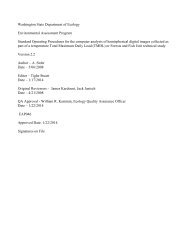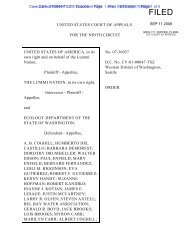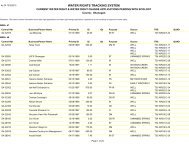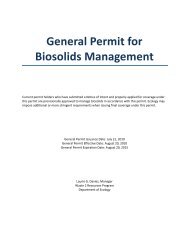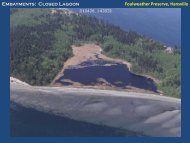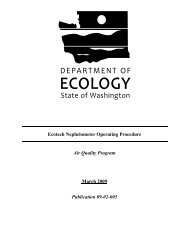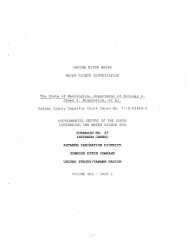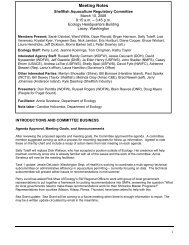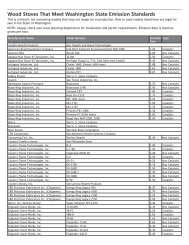WRIA 62 WMP 032305 - Washington State Department of Ecology
WRIA 62 WMP 032305 - Washington State Department of Ecology
WRIA 62 WMP 032305 - Washington State Department of Ecology
You also want an ePaper? Increase the reach of your titles
YUMPU automatically turns print PDFs into web optimized ePapers that Google loves.
March, 2005 -40- 023-1289-003.3040<br />
• Since most <strong>of</strong> the groundwater supply wells completed in the unconsolidated sand and gravel<br />
aquifers in <strong>WRIA</strong> <strong>62</strong> are shallow and relatively close to surface water, there is a potential that<br />
some <strong>of</strong> these wells are under the influence <strong>of</strong> surface water. Ultimately, these wells will have to<br />
comply with guidelines set forth by <strong>Washington</strong> <strong>State</strong> DOH (DOH, 2003).<br />
• For both the Pend Oreille River and its tributaries, site specific information, such as baseflow<br />
hydrograph evaluation and seepage runs, may be needed to make determinations on the nature <strong>of</strong><br />
the hydraulic interaction between surface water and groundwater.<br />
Based on population projections, the highest population growth rates (and therefore anticipated future<br />
water demand) are predicted to occur within the southern sub-basins, including Calispell, Davis,<br />
Skookum, Kent and McCloud and along the mainstem <strong>of</strong> the Pend Oreille River from the Idaho stateline<br />
north to the Ione (Figure 4.2). It is therefore these areas where population growth and water<br />
supply are expected to be a potential concern.<br />
Appropriation <strong>of</strong> water from the <strong>WRIA</strong> <strong>62</strong> sub-basins are limited by <strong>Ecology</strong> administered surface<br />
water source limitations (SWSLs) pursuant to RCW 77.55.050 which states,<br />
“It is the policy <strong>of</strong> this state that a flow <strong>of</strong> water sufficient to support game fish and food fish<br />
populations be maintained at all times in the streams <strong>of</strong> this state. The director <strong>of</strong> ecology<br />
shall give the director notice <strong>of</strong> each application for a permit to divert or store water. The<br />
director has thirty days after receiving the notice to state his or her objections to the<br />
application. The permit shall not be issued until the thirty-day period has elapsed. The<br />
director <strong>of</strong> ecology may refuse to issue a permit if, in the opinion <strong>of</strong> the director, issuing the<br />
permit might result in lowering the flow <strong>of</strong> water in a stream below the flow necessary to<br />
adequately support food fish and game fish populations in the stream. The provisions <strong>of</strong> this<br />
section shall in no way affect existing water rights.”<br />
Those streams on <strong>Ecology</strong>’s Surface Water Source Limited (SWSL) list in <strong>WRIA</strong> <strong>62</strong> have been<br />
identified to have limitations in available water supply as a result <strong>of</strong> fisheries concerns. The <strong>WRIA</strong><br />
<strong>62</strong> streams on the SWSL list are included on Table 4-1 and illustrated on Figure 4.3. In addition,<br />
WDFW has recommended that <strong>Ecology</strong> not grant water rights that have the potential to impact small<br />
streams with less than 5 cfs mean annual flow or water rights from the mainstem <strong>of</strong> the Pend Oreille<br />
River when the seven-day low flow falls below 7,700 cfs. As shown on Figure 4-3 and Table 4-1, the<br />
Calispell, Davis and Skookum sub-basins are considered to have “limitations” with respect to<br />
available water supply and are on the SWSL list. In addition the available flow records for Kent and<br />
McCloud Creeks (Golder, 2005) indicate that the mean annual flows <strong>of</strong> these streams are less than 5<br />
cfs. So, in effect, the sub-basins where growth is anticipated in <strong>WRIA</strong> <strong>62</strong> are closed to further<br />
appropriation by SWSLs unless the appropriation <strong>of</strong> the water can be shown not to impact surface<br />
water pursuant to RCW 77.55050.<br />
The majority <strong>of</strong> the hydrogeolgic information reviewed and assessed within Phase II <strong>of</strong> the watershed<br />
planning process is not sufficiently detailed to completely quantify groundwater resources. However,<br />
conceptual hydrologic and hydrogeologic models can be used to establish hydraulic continuity in<br />
many situations. Groundwater withdrawals, including domestic exempt wells, must not impair senior<br />
water rights nor affect the flow <strong>of</strong> any surface water body (RCW 90.44.030). In addition, <strong>Ecology</strong><br />
considers groundwater to be in continuity with surface water in a sub-basin with surface water<br />
<strong>WRIA</strong> <strong>62</strong> <strong>WMP</strong> <strong>032305</strong>



